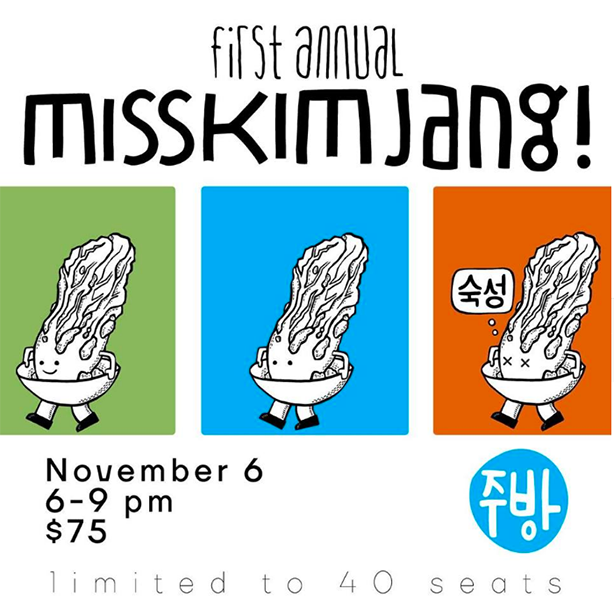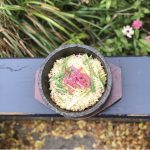First Annual MissKimJang: A Q&A with Ji Hye Kim
Our first annual MissKimJang is Monday, November 6 at Miss Kim. We’ll be celebrating our one year anniversary with this very special Korean tradition. Chef Ji Hye Kim will kick off the event by sharing her deep personal and culinary knowledge of kimchi and KimJang. Attendees will get to make their own kimchi, and we’ll have lots of food, too! Grab a seat before it sells out.
Here’s a preview from Ji-Hye Kim:
KimJang is the annual making and sharing of kimchi. It is an annual event that is at the very core of Korean community. In fact, in some ways almost the entire Korean year is marked by preparations for the annual ritual of KimJang. In spring, shrimp, anchovy and other seafood is set for salting and fermenting. In summer, sea salt is bought for the brine. In late summer, red chili peppers are dried and ground into powder. Finally, in late autumn, or the tenth moon of the Korean Lunar Calendar, it’s KimJang time! Communities coming together to work on the harvest and to make massive amounts of kimchi. Communities working hard together, all hands on deck, to ensure that every home has enough for the long, harsh winter to come.
At Miss Kim, we’re pretty passionate about kimchi and KimJang. In our minds, both are at the very core of what we’re trying to do at Miss Kim—to respectfully represent the Korean cuisine and culture and honor Korean traditions. Kimchi is an inexorable part of the former and KimJang an inexorable part of the latter.
Here’s what she had to say:
G: Why is making kimchi during KimJang relatable to life and death?
JI HYE KIM: The answer to that question starts in Rome. Yes. A story about kimchi and KimJang starts in Rome, Italy. Right before I opened the restaurant, I was living in an extended internship of sorts at the American Academy in Rome. The program was called the Rome Sustainable Food Project—Alice Waters’ brainchild and a brilliant experience.
In that way that life works, one of my fellow travelers at the American Academy was a Korean-American woman—a painter who just happened to be deeply interested in food!
I’d impulsively made a small batch of kimchi for one of the interns who was leaving the program—and now I wanted to make more. My new- found friend and I decided we’d have our own little version of KimJang right there in Rome.
We got all the vegetables we needed from the amazing Mercato Esquilino in Piazza Vittorio. It is one of the largest markets in Rome and is some- times called the immigrant’s market because you can get just about everything there—from traditional Italian produce and delicacies to mangoes and avocados. Then we went to a Korean shop for the ingredients of the filling and we got down to making kimchi.
It was while we were chatting and making kimchi that she said to me:“When you’re making, you have to walk the fine line between life and death.”Those words really resonated with me.Today, we make kimchi at Miss Kim all the time and those words ring even truer.When you brine the cabbage, it is no longer fresh and alive—the real skill in making kimchi is to preserve the crunchiness that the leaves have when the cabbage is alive. In doing so, we prolong its life. Or you could say, we suspend its death.
When I think of the tradition of KimJang, I think it is also walking the fine line between life and death. It’s a communal tradition that goes back so many centuries but it is also so individualistic—an ingenious form of self-expression while also creating community. But it is also a dying tradition. Making kimchi is really hard work— people don’t have the time or energy for all the prepping, brining and dressing that the process requires. The family recipes that were the vehicles for that self expression are being lost.
But, I firmly believe that the tradition of KimJang still has the capacity to survive, and thrive! As long as kimchi remains an essential part of Korean cuisine, KimJang will have a way to be part of Korean culture. Much like we do with the food and our local ingredients at Miss Kim, I’d like to inter- pret the tradition of KimJang and keep it alive in the restaurant.
G: You mentioned individualism and family recipes. At least in the west, kimchi is most popularly thought of as one thing. That red condiment that is served with Korean food. Explain it to us.
JHK: When we say “in the West,” we’re talking about Napa Cabbage kimchi. That’s the kimchi everyone thinks about when they think about Korean food. But kimchi in Korean food can be made of any number of salted and fermented vegetables. Kimchi is the idea of preserving vegetables when they are in season so that they can be eaten all year long. Just about every culture has this tradition of preservation to prepare for the winter months—be it vegetables, meats, or milk.
The most common and the most consumed form of kimchi, is indeed, Napa cabbage kimchi. KimJang occurs in late autumn because it’s when the Napa cabbage and Mu radish are in season. But even within Napa cabbage kimchi, there are variations. Hundreds, if not thousands of recipes, varying by region, wealth, family and ultimately, the individual making the kimchi. Even when the ingredients are exactly the same, self-expression comes through the proportion of the ingredients. There are over 200 documented recipes for kimchi because every fam- ily does it differently.
My mother’s kimchi was her signature. And it said a lot about her. She preferred to honor the flavors of the ingredients rather than subdue them with seasoning. That she came from a region of Korea (around Seoul) where they emphasize clean, subtle flavors, tend to serve small- er portions and have a keen eye for presentation. There’s a definite regionality to kimchi. The farther south you go, the spicier, funkier and punchier the kimchi gets. The farther north you go, the milder it gets.
G: Tell us your very first memory of KimJang.
JHK: I remember my mother sitting in a room and kind of think- ing out loud. It was the day before KimJang. Should we do 50 heads of cabbage or 100 heads of cabbage? My child brain might very well be embellishing or exaggerating those numbers but I was tiny back then—maybe 4 or 5 years old…
This was in Seoul. Back then we lived in an old fashioned house in one of the crowded, older neighborhoods. Our house was old and needed updating. My mother just about hated it, but I have a lot of great memories of that house. My mom’s little outdoor area where she kept her fermented sauces and pastes—witches potions they looked like, with mold and floating bits—brewing in those rustic black pots of hers. Miso pastes, soy sauce, you name it. I remember the feeling of abundance that KimJang brought. There were so, so many heads of Napa cabbage. The kimchi was made outside on the veranda, not in the kitchen. All the women and all the cabbage wouldn’t have fit in our kitchen!
I remember women coming to our house from the neighborhood. I remember them squatting in the yard. The piles and piles of Napa cabbage—heads cut in half. Brine. Drain. Make the filling separate- ly. Fish sauce. Mu Radish—sweet and juicy from the cooler fall tem- peratures, unlike the spicier summer radish. Four or five women to a large mixing bowl—more like a big tub when I think about it.
I remember the vibrant colors. White. Purple. Green. Bright red plastic gloves bought by the dozen. All the women wearing them. I remember the searing red of the chile flakes—my mother would sun dry the chiles on picnic mats all summer while they were in season. But most of all, I remember the feeling of community. The laughing and talking. The hard, hard work. I remember how there was this unspoken but very tangible awareness that we would be eating what was being made for months and months and months.
G: What does KimJang mean to you?
JHK: Back then, when I was a little kid, what I recall is that KimJang was a lot of work but I didn’t do any. I remember my mother, fingers glistening with spices, popping these bite sized Napa cabbage wraps into my mouth. ‘It’s delicious,’ she’d say, which was strange because it was that spicy, pungent, salty filling and cabbage. But I always obediently opened my mouth. Later we’d have it with braised pork belly for dinner.
I remember that when it was KimJang time, my mom didn’t seem as stressed out as usual, even when she was planning it. She would catch me stealing the sweet mu radishes and eating them like Asian pears and teasingly warn me about the terrible flatulence it was going to give me.
And I remember there was just a lot of talking and laughter and it was really powerful to see all these women do their work. It was their day. Unlike when they cooked for the Korean festivals, there wasn’t any- one to serve afterwards, even them- selves. And the social and cultural hierarchy didn’t matter. There were all equals, hanging out and having fun. I loved witnessing that and now I long to recreate it.
G: How has KimJang changed?
JHK : When I was in the second grade we moved from our traditional house in the old neighborhood to an apartment complex in a more modern neighborhood. We still did KimJang but the community thing was hard to pull off in an apartment complex. I don’t remember those magical moments in the yard but I do remember this—I remember being asked to keep watch while my mom and my aunties [the bio- logical variety and the neighborhood variety!] dug a hole in the flower beds of the apartment complex and buried these giant jars of kimchi (I could have fit in them) and then cover them with leaves.
The story of KimJang when we came to America? [laughs] It gets really sad. My mother worked 18 hours a day. She still did KimJang but it was completely different. Back in Seoul, during KimJang season, guys would appear in our neighborhood with pickup trucks and megaphones to announce their presence. My mom would go out and get our Napa cabbage from them. Or she would go to the largest vegetable market in Seoul to get the cabbage—imagine a farmer’s market on steroids! Needless to say, this is not what happened once we moved to America. Instead, most Korean Americans we knew just drove a few miles to a Korean grocery store and bought jars of pre-made kimchi.
Even in Korea, there are now a million sources of pre-made kimchi— kimchi factories! And for the slightly more diligent or picky, thousands of sources of the components of kimchi. You can just make the filling at home and buy pre-brined cabbage.
No matter if in America or Korea, I cannot imagine my mother buying pre-made kimchi. She knows too well that the texture and flavor of kimchi is all in the brining, so even when we came to America, she still made our kimchi from scratch but it was not seasonal and definitely not as communal. She might have had help from my brother and shared it with my aunt but it didn’t feel like the magical communal event we used to have when we were in Seoul.
G: You’re hosting your own version of KimJang, MissKimJang, in the restaurant in November. What are you trying to do with it? What are you trying to make of it?
JHK: In some ways, we’re trying to do the same thing that we do with the food. Honor Korean cuisine and tradition in our little corner of Michigan—with its signature seasons and produce. We try to study and read as much as we can so that we might understand the intent behind and evolution of the recipes and be able to thoughtfully interpret and evolve them for Michigan. We try to serve food that evokes feelings just as much as we’re trying to authentically represent the flavors.
And I’d say, that’s what we’re trying to do with this annual tradition of MissKimJang.
Don’t miss a chance to experience this fun, cultural event. We only have 40 spots for MissKimJang, so grab yours today!





Zingerman’s Art for Sale